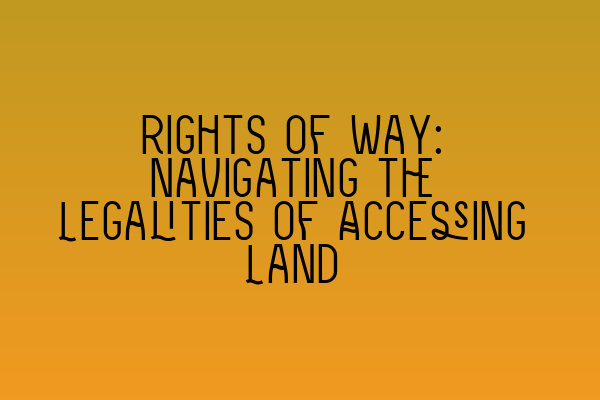Rights of Way: Navigating the Legalities of Accessing Land
Access to land is a fundamental aspect of property ownership and usage. Whether you are a homeowner, a business owner, or a land developer, understanding your rights of way is crucial to ensure proper access and avoid any legal disputes. In this article, we will unravel the complexities of rights of way, exploring their legalities and providing you with essential information to navigate this area of property law.
What are Rights of Way?
Rights of way refer to legal permissions granted to individuals or entities to pass over or use a specific portion of another person’s property. These rights are typically granted to ensure access to landlocked properties or to provide convenient paths between different properties. Rights of way can be either public or private, and the terms and conditions may vary depending on the specific circumstances and agreements in place.
Types of Rights of Way:
1. Public Rights of Way: These are paths or routes that are available for public use, usually established by historical usage, statutory dedication, or official designation. Public rights of way can include footpaths, bridleways, and byways open to all traffic (BOATs). These rights are protected by law and cannot be obstructed or closed without proper legal procedures.
2. Private Rights of Way: Private rights of way are granted to specific individuals or entities and are not available for general public use. These rights can be created through express agreements in deeds, such as granting an easement, or through legal prescriptions due to long-term usage. Private rights of way are subject to the terms and conditions agreed upon in the relevant legal documents.
Understanding the Legalities:
To gain a better understanding of the legalities surrounding rights of way, it is crucial to consider the following key points:
1. Creation and Documentation: The creation of a right of way is typically documented in legal agreements, such as deeds or contracts. These documents should clearly outline the extent of the right, any limitations or restrictions, and any maintenance obligations. It is important to carefully review and understand these documents to ensure compliance and avoid potential disputes.
2. Rights and Responsibilities: Rights of way come with responsibilities for both the grantor and the grantee. The grantor is responsible for maintaining the land and ensuring the right of way is accessible, while the grantee must exercise the right in a reasonable manner, without causing damage or obstruction. Understanding these rights and responsibilities is vital to prevent conflicts and maintain a healthy relationship between all parties involved.
3. Disputes and Resolutions: Despite clear documentation and agreements, disputes regarding rights of way can still arise. Common disputes may include obstructions, excessive use, or disagreements over maintenance responsibilities. In such cases, it is advisable to seek legal advice to ensure your rights are protected and explore potential resolutions, such as negotiation, mediation, or court proceedings if necessary.
Protecting Your Rights of Way:
To protect your rights of way and ensure smooth access to your property, consider the following steps:
1. Thorough Documentation: Keep copies of all relevant documents, including deeds, contracts, and any correspondence related to the rights of way. These documents serve as evidence and can be crucial in resolving any potential disputes.
2. Regular Inspections: Regularly inspect the area to ensure compliance with the terms of the right of way. Address any concerns promptly, such as unauthorized obstructions or inadequate maintenance.
3. Professional Legal Advice: If you are unsure about your rights, obligations, or if you encounter a dispute, seek professional legal advice from a property law expert. They can guide you through the legal complexities and help you protect your rights in the best possible way.
Conclusion:
Understanding your rights of way is essential for property owners and users to ensure proper access and avoid legal disputes. By comprehending the legalities surrounding rights of way, including their types, creation, responsibilities, and potential disputes, you can navigate this area of property law with confidence. Remember to protect your rights through thorough documentation, regular inspections, and seeking professional legal advice when needed.
For further information on related legal topics, you may find the following articles helpful:
– Unraveling the Complexities of UK Bail Laws
– Remand in Custody: Understanding Detention Prior to Trial
– Appeals in Criminal Law: A Roadmap to Seeking Justice
– Exclusion of Evidence: Understanding Grounds and Implications
– Understanding Sentencing Guidelines in UK Criminal Cases
At SQE Property Law & Land Law, we specialize in providing expert legal advice and guidance on all aspects of property law, including rights of way. Contact us today to ensure your rights and interests are protected.
